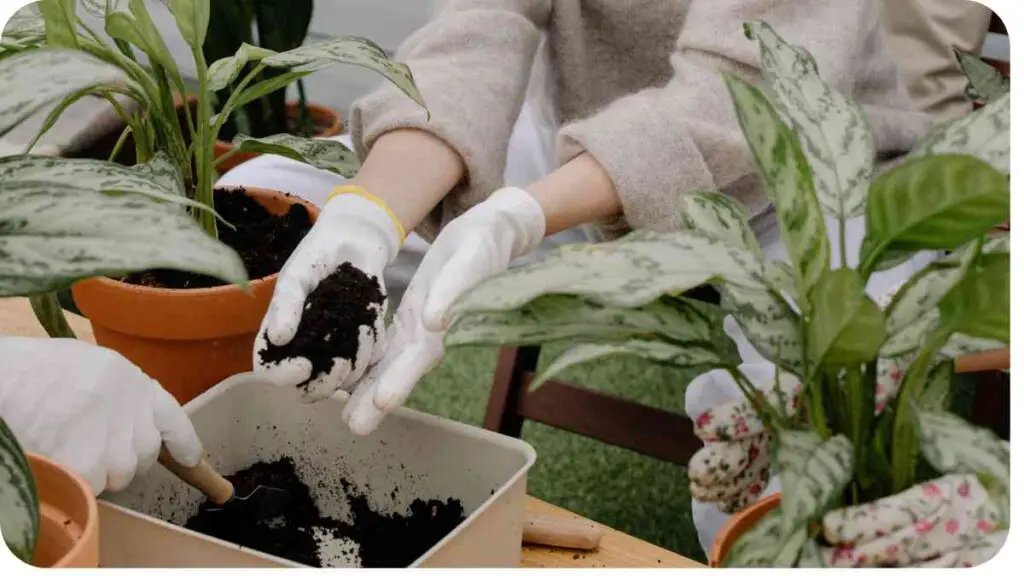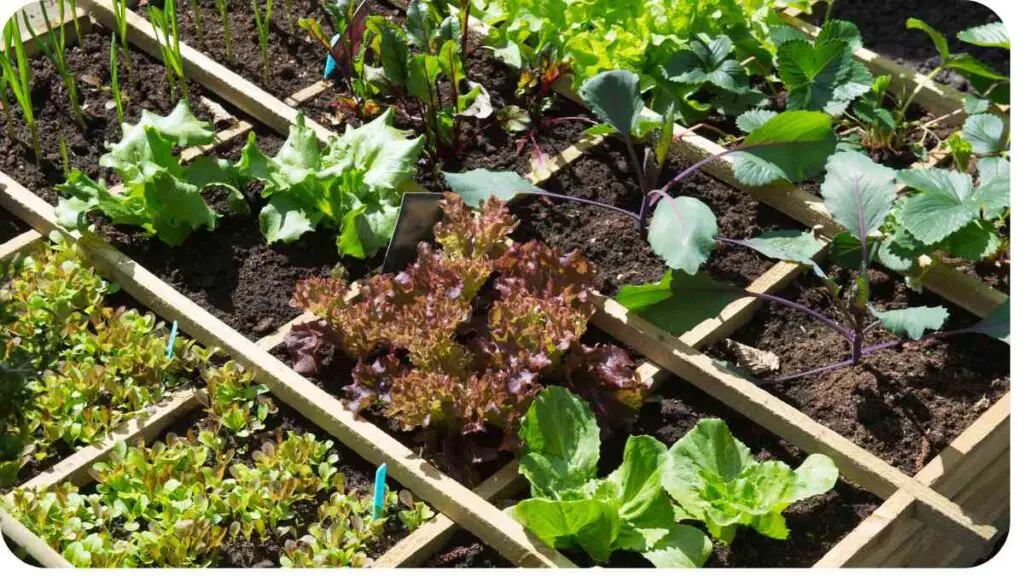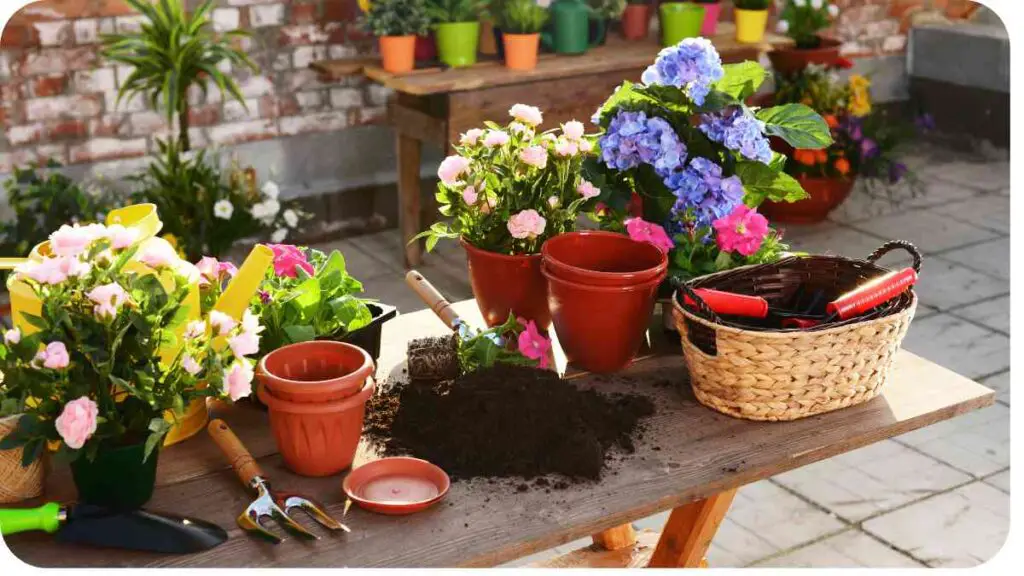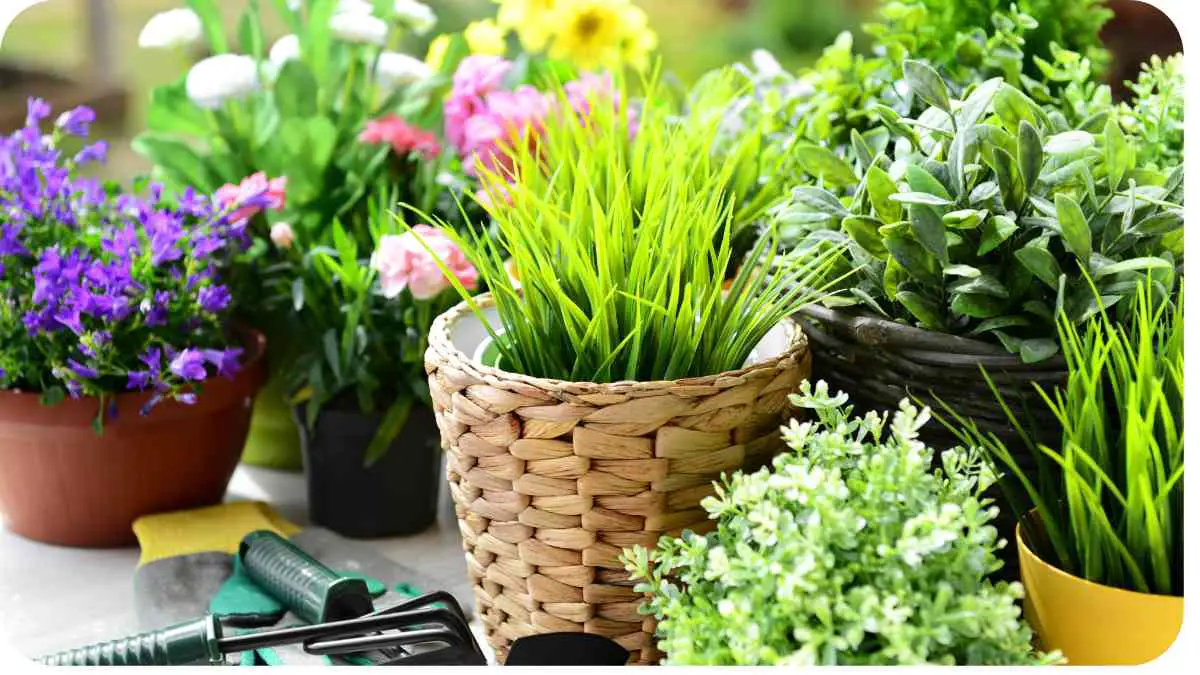Container gardening offers versatility and convenience for individuals with limited space or those seeking to add greenery to their patios, balconies, or window sills. However, one common issue that gardeners encounter is drainage problems, which can compromise the health of plants.
In this comprehensive guide, we’ll delve into the intricacies of dealing with drainage issues in container gardens and provide practical solutions to ensure optimal plant growth.
| Takeaways |
|---|
| Proper drainage is crucial for the health of container gardens. |
| Signs of poor drainage include wilting leaves and foul odors. |
| Common causes of drainage problems include inadequate drainage holes and overwatering. |
| Solutions include using well-draining soil mixes and elevating containers. |
| Regular maintenance and monitoring are essential for healthy drainage. |
2. Understanding Drainage Issues in Container Gardens

Container gardens differ from traditional gardens in terms of drainage dynamics. Unlike plants in the ground, which have natural drainage, container plants rely on the design and materials of their pots for proper water management. Understanding how water behaves in containers is crucial for preventing waterlogging and root rot.
Improving drainage is vital for healthy gardens. To avoid waterlogged containers, follow these common issues and fixes to enhance your garden’s drainage system.
| Aspect | Description |
|---|---|
| Water Movement | Gravity pulls water downward, causing it to collect at the bottom of the container. |
| Soil Saturation | Excess water saturates the soil, displacing oxygen and suffocating plant roots. |
| Container Design | Poorly designed containers may lack drainage holes or have inadequate drainage systems. |
3. Signs of Poor Drainage
Identifying signs of poor drainage early can help prevent irreversible damage to your container garden. Look out for the following indicators:
| Sign | Description |
|---|---|
| Wilting Leaves | Despite watering, plants exhibit signs of dehydration and wilting. |
| Yellowing Foliage | Yellow or brown leaves indicate waterlogged soil and nutrient deficiency. |
| Foul Odors | A musty or sour smell emanating from the soil suggests stagnant water. |
| Mold or Mildew | Damp conditions promote the growth of mold or mildew on the soil surface. |
4. Common Causes of Drainage Problems

Several factors contribute to drainage issues in container gardens, including:
| Cause | Description |
|---|---|
| Inadequate Drainage Holes | Containers without drainage holes restrict water from escaping, leading to waterlogging. |
| Compacted Soil | Dense soil impedes water drainage and restricts root growth. |
| Impermeable Containers | Non-porous materials such as metal or glazed ceramic hinder water drainage. |
| Overwatering | Excessive watering overwhelms the soil’s capacity to drain, causing water buildup. |
5. Solutions for Improving Drainage
Addressing drainage problems requires a combination of preventive measures and corrective actions. Here are some effective solutions to enhance drainage in your container garden:
Maintaining a pest-free garden is essential for plant health. Learn effective tips and tricks for dealing with pests to protect your container garden from destructive insects and critters.
Elevate Containers
Raise your pots using pot feet or bricks to allow excess water to flow freely from the drainage holes. Elevating containers also prevents water from pooling underneath, reducing the risk of root rot.
Use Potting Mixes with Perlite
Incorporate perlite a lightweight, porous material into your potting mix to improve aeration and drainage. Perlite helps prevent soil compaction and facilitates water movement within the container.
| Potting Mix Component | Purpose |
|---|---|
| Peat Moss | Retains moisture |
| Perlite | Enhances drainage |
| Compost | Provides nutrients |
| Vermiculite | Improves soil structure |
| Sand | Increases drainage capacity |
Install Drainage Layers
Place a layer of coarse gravel, broken pottery shards, or foam peanuts at the bottom of your container before adding soil. This creates airspace and prevents the soil from becoming waterlogged.
| Material | Purpose |
|---|---|
| Coarse Gravel | Facilitates water drainage |
| Pottery Shards | Promotes airflow and prevents soil compaction |
| Foam Peanuts | Lightweight option for improved drainage |
Monitor Watering Frequency
Establish a consistent watering schedule based on the moisture needs of your plants and environmental conditions. Avoid overwatering by allowing the top inch of soil to dry out between waterings.
6. Choosing the Right Containers

Selecting the appropriate containers is crucial for ensuring adequate drainage in your garden. Consider the following factors when choosing pots:
Fungal diseases can harm your plants. Recognize symptoms and treatments for common fungal diseases to keep your container garden thriving and disease-free.
Drainage Holes
Opt for containers with multiple drainage holes located at the base to facilitate water drainage. Avoid decorative pots without drainage holes, as they trap excess water and promote root rot.
Container Size
Choose containers proportionate to the size of your plants’ root systems. Oversized pots retain excess moisture, while undersized pots restrict root growth and drainage.
Material
Prefer containers made from porous materials such as terracotta or unglazed ceramic, which allow moisture to evaporate through the sides. Avoid impermeable materials like plastic or metal, which impede drainage.
7. Selecting the Appropriate Soil
The type of soil you use directly influences drainage and plant health in container gardens. Here’s how to select the right soil for optimal drainage:
Well-Draining Mix
Choose a high-quality potting mix specifically formulated for container gardening. Look for mixes labeled as “well-draining” or “lightweight,” as they contain ingredients that promote proper aeration and water drainage.
DIY Soil Amendments
Modify commercial potting mixes by adding organic matter such as compost or coconut coir to improve drainage and nutrient retention. Incorporating coarse sand or perlite can also enhance soil structure and prevent compaction.
| Soil Amendment | Purpose |
|---|---|
| Compost | Enriches soil with nutrients |
| Coconut Coir | Retains moisture and improves aeration |
| Coarse Sand | Increases drainage capacity |
Test Soil Drainage
Conduct a simple drainage test before planting by filling the container with water and observing how quickly it drains. Ideally, water should flow freely through the drainage holes within a few seconds, indicating adequate drainage.
Revitalize your outdoor space with restored furniture. Discover methods for restoring weathered wooden outdoor furniture to bring new life to your garden seating and decor.
8. Utilizing Drainage Materials
In addition to proper container selection and soil preparation, incorporating drainage materials can further improve water management in your container garden:
Smart Pots
Consider using fabric pots, such as Smart Pots or grow bags, which promote air pruning and prevent overwatering by allowing excess moisture to evaporate through the sides.
| Benefits of Smart Pots | Description |
|---|---|
| Air Pruning | Encourages root development and prevents circling roots |
| Temperature Regulation | Keeps roots cooler in hot weather conditions |
| Improved Drainage | Facilitates airflow and prevents waterlogging |
Self-Watering Containers
Explore self-watering container options equipped with built-in reservoirs that supply water to plants as needed. These containers regulate moisture levels, reducing the risk of both overwatering and underwatering.
| Advantages of Self-Watering Containers | Description |
|---|---|
| Water Efficiency | Minimizes water wastage |
| Consistent Moisture | Provides a steady water supply |
| Reduced Maintenance | Requires less frequent watering |
9. Proper Watering Techniques
Applying proper watering techniques is essential for maintaining optimal moisture levels and preventing drainage problems in container gardens:
Water at the Base
Directly water the soil at the base of the plants rather than overhead to minimize splashing and reduce the risk of fungal diseases. This ensures that water reaches the root zone where it’s needed most.
Monitor Soil Moisture
Regularly check the moisture level of the soil by inserting your finger into the top inch. Water only when the soil feels dry to the touch, as overwatering can lead to waterlogged conditions and root rot.
Adjust Watering Frequency
Adjust your watering frequency based on environmental factors such as temperature, humidity, and sunlight intensity. Plants may require more frequent watering during hot, dry weather and less during cooler periods.
Use Mulch
Apply a layer of organic mulch, such as shredded bark or straw, to the soil surface to help retain moisture, regulate soil temperature, and suppress weed growth. Mulching also reduces water evaporation from the soil.
Maintain stable pathways for a safe garden environment. Follow steps to address stone pathway shifts and sinking issues and ensure a sturdy and attractive walkway in your container garden.
10. Maintenance Tips for Healthy Drainage
Regular maintenance is key to ensuring healthy drainage and preventing issues in your container garden. Follow these maintenance tips to keep your plants thriving:
Clear Drainage Holes
Periodically check and clear the drainage holes of debris or blockages to ensure proper water flow. Use a small brush or skewer to remove any obstructions that may impede drainage.
Rotate Containers
Rotate containers regularly to promote even growth and prevent roots from becoming congested on one side. This encourages balanced moisture distribution and prevents soil compaction.
Monitor Plant Health
Keep an eye on the overall health of your plants, including foliage color, growth rate, and pest/disease presence. Address any issues promptly to prevent them from escalating and affecting drainage.
Repot When Necessary
Repot plants into larger containers as they outgrow their current pots to prevent overcrowding and improve drainage. Use fresh potting mix and ensure proper drainage in the new container.
11. Case Study: Overcoming Drainage Challenges
Let’s take a look at a real-life example of how a gardener successfully addressed drainage problems in their container garden:
Case Study: Maria’s Herb Garden
Maria, an avid gardener, noticed that her herbs were struggling due to poor drainage in their containers. The soil remained soggy after watering, leading to root rot and stunted growth.
After assessing the situation, Maria implemented several strategies to improve drainage:
- Switched to Smart Pots: Maria replaced her traditional plastic pots with breathable fabric Smart Pots, which allowed excess moisture to evaporate more effectively.
- Amended Soil Mix: She amended her potting mix with perlite and compost to enhance drainage and nutrient retention, creating a more suitable growing environment for her herbs.
- Adjusted Watering Practices: Maria adjusted her watering frequency and only watered when the top inch of soil felt dry to the touch, preventing overwatering and waterlogged conditions.
As a result of these changes, Maria’s herbs rebounded and began thriving in their new, well-draining containers. She enjoyed a bountiful harvest of fresh herbs throughout the growing season.
12. Expert Tips from Gardeners
Gaining insights from experienced gardeners can provide valuable perspectives and additional strategies for addressing drainage problems. Here are some expert tips shared by seasoned gardeners:
Tip 1: “Choose Containers Wisely” – Sarah Green
“Select containers with adequate drainage holes and avoid decorative pots without proper drainage. Opt for larger containers to provide ample space for root growth and water movement.”
Tip 2: “Invest in Quality Potting Mix” – John Smith
“Invest in a high-quality potting mix that is well-draining and nutrient-rich. Consider adding organic matter such as compost or coconut coir to improve soil structure and moisture retention.”
Tip 3: “Water Wisely” – Emily Jones
“Water your container plants deeply but less frequently to encourage deep root growth and prevent waterlogging. Monitor soil moisture levels regularly and adjust your watering schedule accordingly.”
Tip 4: “Implement Raised Beds” – Michael Chen
“If space allows, consider using raised beds for your container garden. Raised beds provide excellent drainage and aeration, promoting healthier plant growth and reducing the risk of waterlogged soil.”
13. Conclusion
Dealing with drainage problems in container gardens is a common challenge faced by many gardeners. However, with the right knowledge and strategies, it’s possible to create an environment that promotes optimal drainage and plant health.
By understanding the causes of poor drainage, selecting appropriate containers and soil mixes, and implementing effective watering and maintenance practices, you can prevent waterlogged conditions and ensure the success of your container garden.
Remember to regularly assess your plants’ health, adjust your watering practices as needed, and seek advice from fellow gardeners or experts if you encounter any issues along the way. With patience, care, and attention to detail, you can enjoy a thriving container garden filled with lush, healthy plants.
Further Reading
- Container Gardening: Drainage Options (University of Illinois Extension): Explore various drainage options for container gardens, including drainage materials and techniques to improve water management.
- Improving Poor Drainage in the Garden (Better Homes & Gardens): Learn practical tips and techniques for enhancing drainage in your garden to promote healthier plant growth and prevent waterlogging.
- 7 Solutions to Drainage Problems in the Garden (Todd Haiman Landscape Design): Discover seven effective solutions for addressing drainage issues in your garden, from incorporating raised beds to implementing rain gardens.
FAQs
Can I use regular garden soil in my container garden?
No, it’s not recommended to use garden soil in containers due to its heavy texture and poor drainage properties. Opt for a well-draining potting mix specifically formulated for container gardening.
How often should I water my container plants?
Watering frequency depends on factors such as plant type, container size, and environmental conditions. Monitor soil moisture levels and water when the top inch of soil feels dry to the touch.
What should I do if my plants are already showing signs of poor drainage?
If your plants are exhibiting signs of poor drainage, take immediate action to improve the situation. Consider repotting them into containers with better drainage, amending the soil mix, and adjusting your watering practices.
How can I prevent drainage problems in my container garden?
Preventing drainage problems involves choosing the right containers, using well-draining soil mixes, and implementing proper watering techniques. Regular maintenance and monitoring are also essential to ensure healthy drainage.
Are there specific plants that are more tolerant of poor drainage?
Yes, some plants are more tolerant of wet soil conditions than others. Consider selecting plants that thrive in moist environments, such as bog-loving perennials or water-loving vegetables like watercress and watermelon.

Hi! My name is Hellen James, and I’m here to help you with your home-maintenance needs. Whether it’s building a better yard or just trying to fix a garden—I can show you how.


